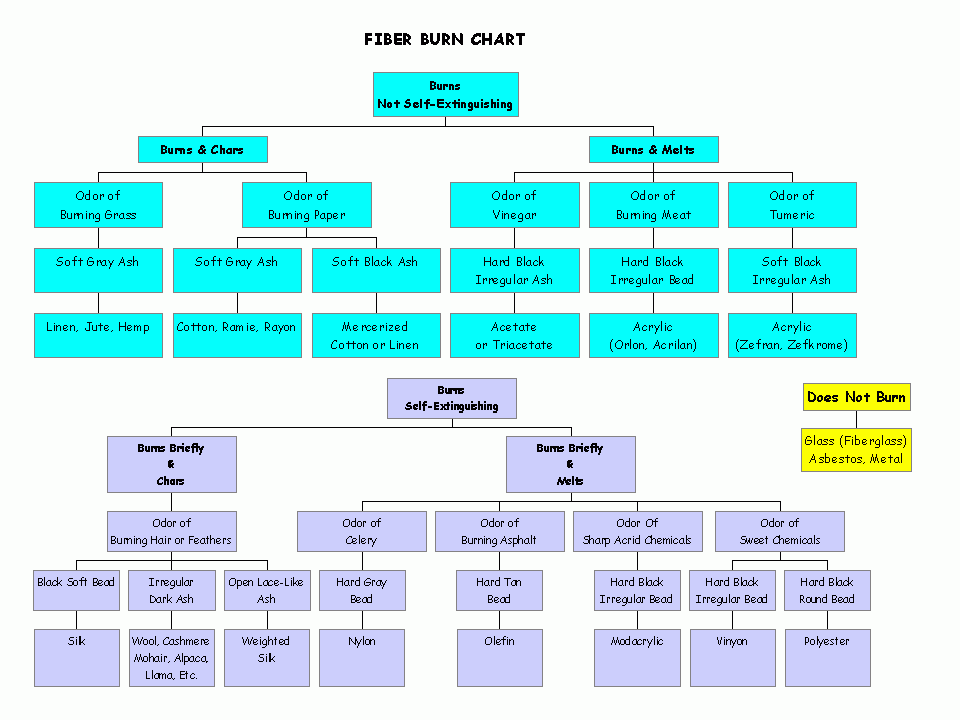Fibre Identification By Burning Test – Fabric burn test chart
Jump To:
Learn How to Perform a Burn Test to Determine Fabric Composition! Indeed, this test (also called the match test) makes it possible to identify the fibers constituting a fabric since all the fibers burn differently. This is very useful if you find a piece of fabric but cannot tell by touch its composition. Thus, you will be able to know if you have to do with polyester (polyester burn test), silk, wool, acetate, viscose, or nylon among others.
This test involves exposing a fabric sample to a flame and analyzing how it burns, the odor generated and the waste produced by combustion.
Material for combustion test
- Some samples (2cm by 2)
- An explosion-proof (fire-resistant) container such as a large ashtray
- Long matches
- Long forceps or hemostats
You can do this test over a sink, just in case!
How to perform the combustion test
Carry out the test outdoors if possible or in a well-ventilated area, away from flammable objects.
Step 1
Place a sample in the container and set a corner on fire
Step 2
Pay attention to the smell that emanates from it
- Burnt cotton smells like burnt paper and remains glowing at the end of the burn
- A smell similar to burnt hair indicates wool or silk, but silk does not always burn as easily as wool)
- A dark plume of smoke that smells of chemical or burnt plastic likely means the fabric is a cotton/polyester blend.
Fabric burn test chart:

Step 3
Examine the ashes after they have cooled
- Cotton ashes are light and fine and become dust
- Black and brittle residues, which crush under the fingers are surely the remains of wool
- Small, hard balls are the residues of melted synthetic fibers.
Step 4
Unravel another sample to take a bunch of threads. Holding them with pliers above the container, slowly approach a flame towards these wires
- Cotton fibers ignite as soon as the flame approaches
- Synthetic fibers wrap around themselves to keep away from heat and tend to melt
You can have fun testing fabrics you already know the composition of. Download the table to keep the results of the combustion test in your sewing corner.
Fabrics that look like cotton
- The flax product residue is similar to that of cotton but burns more slowly.
- Viscose continues to burn once the flame is removed and does not remain glowing.
How do you do a burn test?
What are the 3 types of fabric testing?
- Textile Testing.
- Functional Textile.
- Analysis of Solid Fuel.
- Chemical Analysis (ECO Lab) Composite Testing.
- Mechanical Testing.
- Heat & Flame Testing.
Does fabric burn easily?
All fabrics will burn, but some are more combustible than others. Untreated natural fibers such as cotton, linen, and silk burn more readily than wool, which is more difficult to ignite and burns with a low flame velocity. The weight and weave of the fabric will affect how easily the material will ignite and burn.
How do you test fabric?
To conduct a test, cut a small sample of fabric, hold it with a pair of tweezers and place it over a small flame. Take all necessary precautions and keep a bowl of water nearby to extinguish the flame when the test is complete.
How do you test cotton fabric?
You can test fabric for 100% cotton using the burn test. Take a few fibers and hold them against a flame. 100% cotton will not curl from the heat. It smells like burning paper and leaves grayish ash without signs of melting.
How do you treat a burn from fabric?
If it is a first-degree rope burn, apply a topical antibiotic cream (like Neosporin), topical aloe, or a thin layer of petroleum jelly (like Vaseline) over the burn to help prevent infection. Jill’s fave option is Lucas Papaw Ointment. Cover the burn with a dry piece of gauze or a bandage.
What is fabric inspection system?
Fabric Inspection is the systematic observation of fabrics to decide whether it meets: Client’s specification in terms of count/construction, color, design, measurement specifications, hand/feel, and other specific quality parameters laid down by the clients.
What is a textile lab?
The Textile Testing Lab provides assistance to the textile and apparel industry through the development of high-quality products, evaluation and/or development of specifications for an existing product, and/or evaluation of the end-use performance of a product.
How many types of fabric testing are there?
Types of Textile testing.
- Fiber test: identification of fiber length, elongation, strength, etc.
- Yarn test: yarn count, strength, appearance, twist per unit length, etc.
Is 100 percent polyester flammable?
Polyester fibers in synthetic fabric are not flammable. Polyester fabric, though, is only flame-resistant. This fabric will melt at a high temperature, but it resists burning. These poly blends can be much more flammable than 100% polyester.
What happens when polyester is burnt?
Polyester: It will shrink from the flame and burn slowly giving off black smoke. Has a somewhat sweet chemical odor. The residue is initially a hard cream-colored bead that becomes a darker tan.
At what temperature does polyester catch fire?
Polyester has an ignition temperature of around 432 to 488 degrees Celsius, that’s 809 to 910 degrees Fahrenheit.
How can you tell if fabric is 100 linen?
You can see slubs in linen fabrics, and small bumps throughout the weave, and feel them with your hand. Fake linen is very flat and even in appearance. Look up close as the linen fiber is much coarser and thicker than other natural fibers such as cotton yarn. It’s rough as well but gets smoother over time.
Which method is used to blend test for fabric?
An infrared spectrophotometer is used to separately identify synthetic fibers in the blended fabric.
